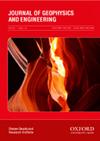Improved adaptive thin-layer inversion for semi-airborne transient electromagnetic
IF 1.7
3区 地球科学
Q3 GEOCHEMISTRY & GEOPHYSICS
引用次数: 1
Abstract
To improve the resolution of electromagnetic inversion for thin layers, electromagnetic one-dimensional inversion was studied. The smooth conductivity model produced by Occam's inversion cannot accurately represent the information of the subterranean thin resistive layers, leading to erroneous inversion findings. The existing thin resistive layers’ inversion method sets the model constraint term at the thin resistive layers to 0, resulting in abrupt changes in resistivity values. Given the above problems, we proposed an adaptive roughness matrix calculation method to improve the thin, lowly resistive-layer resolution. The resistivity difference between neighboring layers of the updated inversion model determines the roughness matrix, allowing for the realization of adaptive inversion of the thin layer. It achieves semi-airborne transient electromagnetic enhanced adaptive thin-layer inversion and automatically manages the model constraint term. The calculation of the synthetic model demonstrates that the improved adaptive thin-layer inversion method does not need to know the thin, lowly resistive layers information in advance. The model can produce appropriate inversion results regardless of the presence of thin, lowly-resistive layers. Finally, the drilling results are consistent with the inversed appearance of the semi-airborne transient electromagnetic field data. Other geophysical adaptive thin resistive layers inversion can also benefit from this research's findings.半机载瞬变电磁的改进自适应薄层反演
为提高薄层电磁反演的分辨率,开展了一维电磁反演研究。Occam反演得到的光滑电导率模型不能准确反映地下薄阻层的信息,导致反演结果错误。现有的薄阻层反演方法将薄阻层处的模型约束项设为0,导致电阻率值发生突变。针对上述问题,提出了一种自适应粗糙度矩阵计算方法,以提高薄、低电阻层的分辨率。更新后的反演模型的相邻层间电阻率差决定了粗糙度矩阵,实现了薄层自适应反演。实现了半机载瞬变电磁增强自适应薄层反演,并对模型约束项进行了自动管理。综合模型的计算表明,改进的自适应薄层反演方法不需要事先知道薄层、低阻层的信息。无论是否存在薄的低阻层,该模型都能产生合适的反演结果。最后,钻探结果与半机载瞬变电磁场数据的反演结果一致。其他地球物理自适应薄电阻层反演也可以受益于本研究的发现。
本文章由计算机程序翻译,如有差异,请以英文原文为准。
求助全文
约1分钟内获得全文
求助全文
来源期刊

Journal of Geophysics and Engineering
工程技术-地球化学与地球物理
CiteScore
2.50
自引率
21.40%
发文量
87
审稿时长
4 months
期刊介绍:
Journal of Geophysics and Engineering aims to promote research and developments in geophysics and related areas of engineering. It has a predominantly applied science and engineering focus, but solicits and accepts high-quality contributions in all earth-physics disciplines, including geodynamics, natural and controlled-source seismology, oil, gas and mineral exploration, petrophysics and reservoir geophysics. The journal covers those aspects of engineering that are closely related to geophysics, or on the targets and problems that geophysics addresses. Typically, this is engineering focused on the subsurface, particularly petroleum engineering, rock mechanics, geophysical software engineering, drilling technology, remote sensing, instrumentation and sensor design.
 求助内容:
求助内容: 应助结果提醒方式:
应助结果提醒方式:


